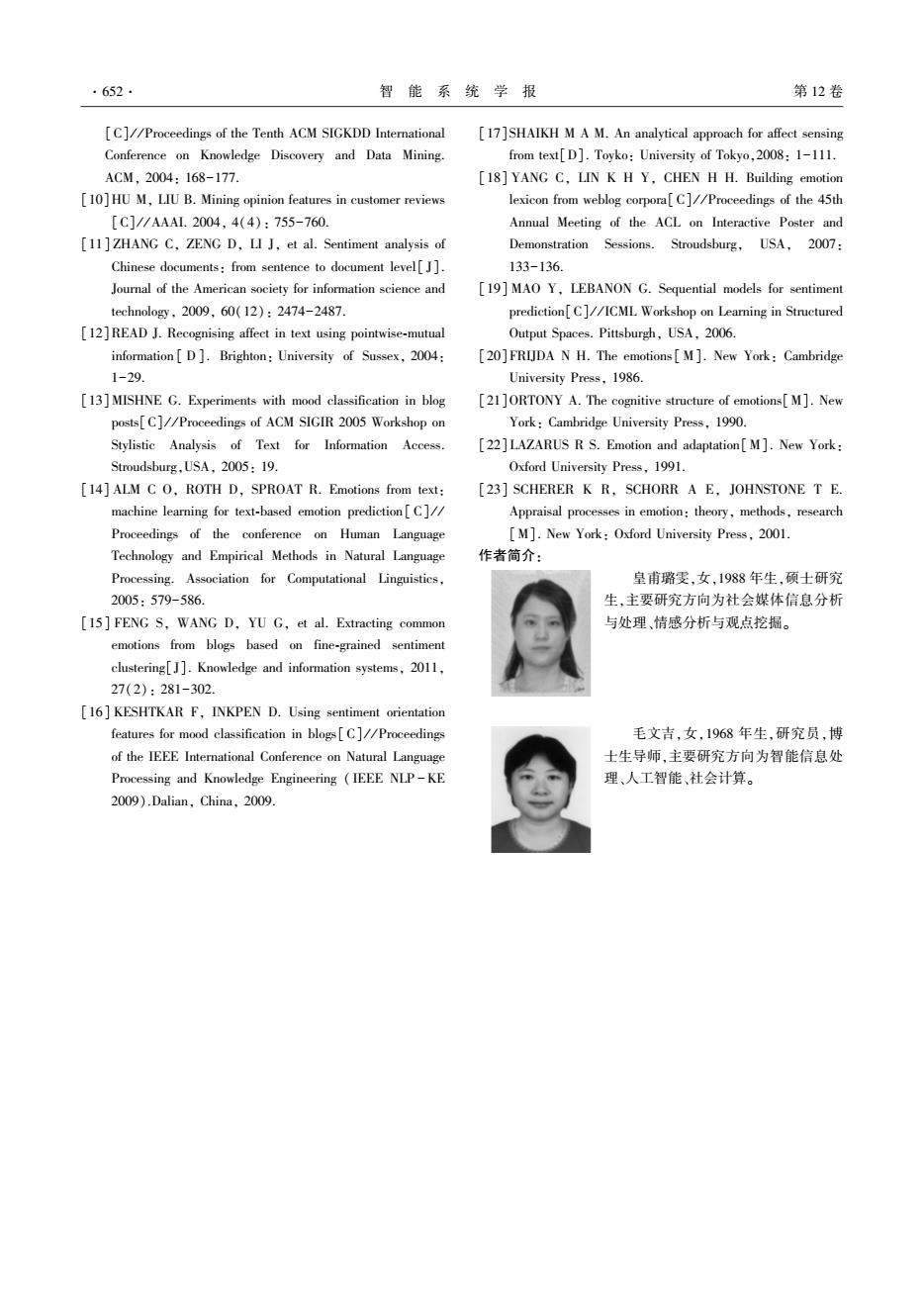正在加载图片...

·652 智能系统学报 第12卷 [C]//Proceedings of the Tenth ACM SIGKDD International [17]SHAIKH M A M.An analytical approach for affect sensing Conference on Knowledge Discovery and Data Mining. from text[D].Toyko:University of Tokyo,2008:1-111. ACM.2004:168-177. [18]YANG C,LIN K H Y,CHEN HH.Building emotion [10]HU M,LIU B.Mining opinion features in customer reviews lexicon from weblog corpora[C]//Proceedings of the 45th [C]/AAAL.2004,4(4):755-760. Annual Meeting of the ACL on Interactive Poster and [11]ZHANG C,ZENG D,LI J,et al.Sentiment analysis of Demonstration Sessions.Stroudsburg,USA,2007: Chinese documents:from sentence to document level[J]. 133-136. Journal of the American society for information science and [19]MAO Y,LEBANON G.Sequential models for sentiment technology,2009,60(12):2474-2487. prediction[C]//ICML Workshop on Learning in Structured [12]READ J.Recognising affect in text using pointwise-mutual Output Spaces.Pittsburgh,USA,2006. information D].Brighton:University of Sussex,2004: [20]FRIJDA N H.The emotions[M].New York:Cambridge 1-29. University Press,1986. [13]MISHNE G.Experiments with mood classification in blog [21]ORTONY A.The cognitive structure of emotions[M].New posts[C]//Proceedings of ACM SIGIR 2005 Workshop on York:Cambridge University Press,1990. Stylistic Analysis of Text for Information Access. [22]LAZARUS R S.Emotion and adaptation M].New York: Stroudsburg,USA,2005:19. Oxford University Press,1991. [14]ALM C O,ROTH D,SPROAT R.Emotions from text: [23]SCHERER K R,SCHORR A E,JOHNSTONE T E. machine learning for text-based emotion prediction[C] Appraisal processes in emotion:theory,methods,research Proceedings of the conference on Human Language [M].New York:Oxford University Press,2001. Technology and Empirical Methods in Natural Language 作者简介: Processing.Association for Computational Linguistics, 皇甫璐雯,女,1988年生,硕士研究 2005:579-586. 生,主要研究方向为社会媒体信息分析 [15]FENG S,WANG D,YU G,et al.Extracting common 与处理,情感分析与观点挖掘。 emotions from blogs based on fine-grained sentiment clustering[J].Knowledge and information systems,2011, 27(2):281-302. [16]KESHTKAR F,INKPEN D.Using sentiment orientation features for mood classification in blogs[C//Proceedings 毛文吉,女,1968年生,研究员,博 of the IEEE International Conference on Natural Language 士生导师,主要研究方向为智能信息处 Processing and Knowledge Engineering IEEE NLP-KE 理、人工智能、社会计算。 2009).Dalian,China,2009.[C] / / Proceedings of the Tenth ACM SIGKDD International Conference on Knowledge Discovery and Data Mining. ACM, 2004: 168-177. [10]HU M, LIU B. Mining opinion features in customer reviews [C] / / AAAI. 2004, 4(4): 755-760. [11] ZHANG C, ZENG D, LI J, et al. Sentiment analysis of Chinese documents: from sentence to document level[ J]. Journal of the American society for information science and technology, 2009, 60(12): 2474-2487. [12]READ J. Recognising affect in text using pointwise⁃mutual information [ D]. Brighton: University of Sussex, 2004: 1-29. [13]MISHNE G. Experiments with mood classification in blog posts[C] / / Proceedings of ACM SIGIR 2005 Workshop on Stylistic Analysis of Text for Information Access. Stroudsburg,USA, 2005: 19. [14] ALM C O, ROTH D, SPROAT R. Emotions from text: machine learning for text⁃based emotion prediction[C] / / Proceedings of the conference on Human Language Technology and Empirical Methods in Natural Language Processing. Association for Computational Linguistics, 2005: 579-586. [15] FENG S, WANG D, YU G, et al. Extracting common emotions from blogs based on fine⁃grained sentiment clustering[J]. Knowledge and information systems, 2011, 27(2): 281-302. [16] KESHTKAR F, INKPEN D. Using sentiment orientation features for mood classification in blogs[C] / / Proceedings of the IEEE International Conference on Natural Language Processing and Knowledge Engineering ( IEEE NLP -KE 2009).Dalian, China, 2009. [17]SHAIKH M A M. An analytical approach for affect sensing from text[D]. Toyko: University of Tokyo,2008: 1-111. [18] YANG C, LIN K H Y, CHEN H H. Building emotion lexicon from weblog corpora[C] / / Proceedings of the 45th Annual Meeting of the ACL on Interactive Poster and Demonstration Sessions. Stroudsburg, USA, 2007: 133-136. [19] MAO Y, LEBANON G. Sequential models for sentiment prediction[C] / / ICML Workshop on Learning in Structured Output Spaces. Pittsburgh, USA, 2006. [20]FRIJDA N H. The emotions[ M]. New York: Cambridge University Press, 1986. [21]ORTONY A. The cognitive structure of emotions[M]. New York: Cambridge University Press, 1990. [22]LAZARUS R S. Emotion and adaptation[M]. New York: Oxford University Press, 1991. [23] SCHERER K R, SCHORR A E, JOHNSTONE T E. Appraisal processes in emotion: theory, methods, research [M]. New York: Oxford University Press, 2001. 作者简介: 皇甫璐雯,女,1988 年生,硕士研究 生,主要研究方向为社会媒体信息分析 与处理、情感分析与观点挖掘。 毛文吉,女,1968 年生,研究员,博 士生导师,主要研究方向为智能信息处 理、人工智能、社会计算。 ·652· 智 能 系 统 学 报 第 12 卷